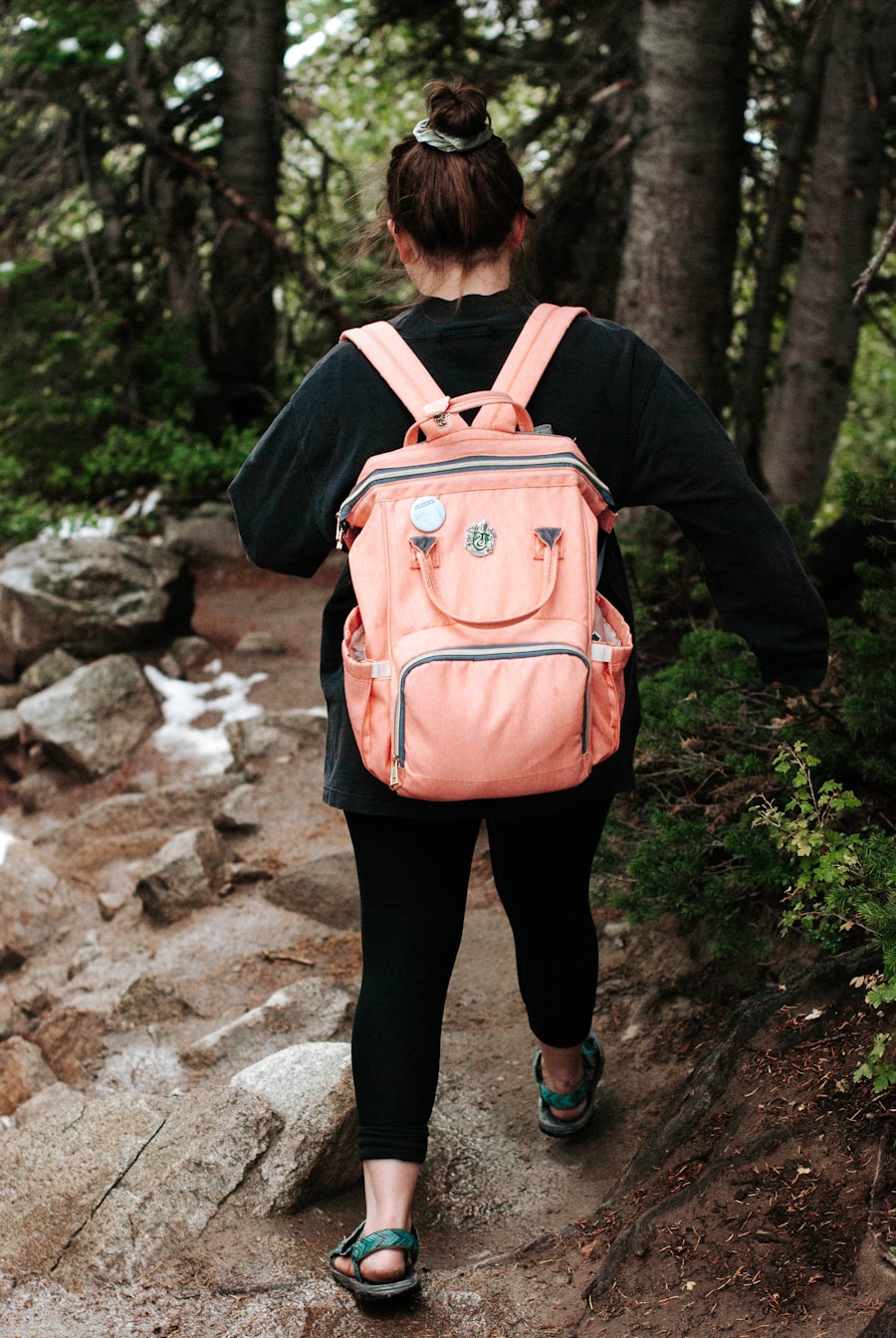Selecting the appropriate backpack for your hiking adventure is a critical first step that can significantly influence your overall experience. The market offers a plethora of options, ranging from daypacks to multi-day backpacks, each designed for specific types of hikes and durations. When choosing a backpack, consider the length of your hike, the terrain, and the amount of gear you need to carry.
For short day hikes, a smaller pack with a capacity of 15 to 30 liters may suffice, allowing you to carry essentials like water, snacks, and a first-aid kit. Conversely, for longer excursions that span multiple days, a larger pack with a capacity of 50 to 70 liters is advisable, as it provides ample space for sleeping gear, cooking equipment, and extra clothing. Another crucial factor in selecting a backpack is its fit and comfort.
A well-fitted backpack should sit snugly against your back without causing discomfort or restricting movement. Look for adjustable straps, padded hip belts, and ventilated back panels that enhance comfort during long treks. Additionally, consider the weight of the backpack itself; lighter models can help reduce fatigue over extended periods.
It’s also beneficial to try on various packs while loaded with weight to simulate the hiking experience. This practice allows you to assess how the pack feels when it’s fully loaded and helps you identify any potential pressure points that could lead to discomfort on the trail.
Key Takeaways
- Choose a backpack with the right size, fit, and features for your hike
- Pack essentials such as water, food, navigation tools, first aid kit, and weather-appropriate clothing
- Properly adjust shoulder straps, hip belt, and load lifters for a comfortable fit
- Distribute weight evenly and balance the load to prevent strain on your body
- Use efficient hiking techniques like taking regular breaks and using trekking poles to conserve energy
Packing Essentials for a Successful Hike
Packing the right essentials is paramount for a successful hiking experience. The first step in this process is to create a checklist tailored to your specific hike. This list should include items that ensure your safety, comfort, and enjoyment throughout the journey.
Water is undoubtedly the most critical item; depending on the length of your hike and weather conditions, you may need to carry enough water for hydration or have a reliable water filtration system if you plan to refill from natural sources. Additionally, snacks high in energy—such as trail mix, energy bars, or jerky—are essential for maintaining stamina. Clothing is another vital component of your packing list.
Layering is key; start with moisture-wicking base layers that keep sweat away from your skin, followed by insulating layers for warmth, and finally a waterproof outer layer to protect against rain or wind. A hat and sunglasses can shield you from sun exposure, while sturdy hiking boots provide necessary support and traction on uneven terrain. Don’t forget to include a first-aid kit stocked with band-aids, antiseptic wipes, and any personal medications you may need.
A multi-tool or knife can also be invaluable for various tasks on the trail.
Properly Adjusting and Fitting Your Backpack

Once you have chosen your backpack and packed your essentials, the next step is to ensure it fits properly. A well-adjusted backpack can make a significant difference in your comfort level while hiking. Start by putting on the backpack and adjusting the shoulder straps so that they sit comfortably on your shoulders without digging in or slipping off.
The straps should allow for a snug fit but still enable you to move freely. Ideally, the top of the pack should rest just below your shoulders, allowing for optimal weight distribution. Next, focus on the hip belt.
This component is crucial for transferring weight from your shoulders to your hips, which are better equipped to handle heavier loads. Adjust the hip belt so that it sits comfortably around your hips and is snug enough to prevent shifting during movement. Many backpacks come with load-lifter straps located near the top of the shoulder straps; these should be adjusted to pull the pack closer to your body while maintaining an upright posture.
Finally, ensure that any additional straps—such as sternum straps—are adjusted to provide extra stability without constricting your breathing.
Distributing Weight and Balancing Your Load
| Vehicle Type | Recommended Weight Distribution | Consequences of Imbalanced Load |
|---|---|---|
| Truck | 60% of weight on front axle, 40% on rear axle | Increased risk of rollovers, reduced steering and braking control |
| RV | 45% of weight on front axle, 55% on rear axle | Uneven tire wear, reduced fuel efficiency, instability on the road |
| Trailer | 10-15% of total weight on hitch | Swerving, fishtailing, loss of control while towing |
Effective weight distribution within your backpack is essential for maintaining balance and reducing fatigue while hiking. The general rule of thumb is to place heavier items closer to your back and higher up in the pack. This positioning helps maintain your center of gravity and prevents excessive strain on your back and shoulders.
For instance, if you are carrying a tent or cooking gear, these should be positioned near your spine rather than at the bottom of the pack. Additionally, utilize smaller compartments and pockets strategically to keep frequently accessed items—such as snacks or maps—within easy reach. This organization not only enhances convenience but also helps maintain balance by preventing larger items from shifting during movement.
When packing clothing or sleeping bags, consider using compression sacks to minimize bulk and create more space within your pack. By carefully considering how you distribute weight and balance your load, you can significantly improve your hiking experience and reduce the risk of injury.
Techniques for Efficiently Hiking with a Backpack
Hiking with a loaded backpack requires specific techniques to maximize efficiency and minimize fatigue. One effective method is to maintain a steady pace that allows you to conserve energy over long distances. Instead of rushing or sprinting up inclines, adopt a rhythm that feels sustainable; this often means taking shorter strides on steep sections while maintaining an even tempo on flat terrain.
Regular breaks are also essential; plan to stop every hour or so to hydrate and refuel with snacks. Another technique involves using trekking poles if you find them helpful. These poles can provide additional stability and support, especially on uneven ground or steep descents.
They allow you to engage your upper body while hiking, distributing some of the load away from your legs and reducing strain on your knees during downhill sections. When navigating tricky terrain or obstacles like rocks or roots, take care to lift your feet high enough to avoid tripping; this becomes even more crucial when carrying a heavy load.
Maintaining Proper Posture and Body Mechanics

Maintaining proper posture while hiking is vital for preventing injuries and ensuring an enjoyable experience. As you walk, focus on keeping your back straight and shoulders relaxed rather than hunched forward under the weight of your pack. Engaging your core muscles can help stabilize your spine and maintain an upright position throughout your hike.
Additionally, be mindful of how you position your head; keeping it aligned with your spine helps prevent neck strain. Foot placement is equally important; aim to step down gently rather than stomping or slamming your feet onto the ground. This technique not only reduces impact on your joints but also allows for better control over uneven surfaces.
When navigating uphill sections, lean slightly forward while keeping your hips aligned over your feet; this posture helps maintain balance and reduces strain on your lower back. Conversely, when descending, shift your weight back slightly onto your heels to prevent slipping and maintain stability.
Tips for Staying Comfortable and Avoiding Injuries
Comfort during a hike is paramount for an enjoyable experience, especially when carrying a backpack. One effective way to enhance comfort is by wearing moisture-wicking clothing that helps regulate body temperature and keeps sweat at bay. Additionally, consider investing in high-quality hiking socks made from materials like merino wool or synthetic blends; these can help prevent blisters by reducing friction between your feet and footwear.
Regularly adjusting your pack throughout the hike can also contribute to comfort levels. As you consume water or snacks from your pack, it may shift slightly; take a moment during breaks to readjust straps and ensure everything remains snug against your body. Pay attention to any signs of discomfort or pain; if something feels off—whether it’s chafing from straps or soreness in specific muscles—address it immediately rather than waiting until it escalates into an injury.
Mastering the Art of Packing and Unpacking Your Backpack
The process of packing and unpacking your backpack can significantly impact both efficiency on the trail and ease at camp. To master this art, develop a systematic approach that allows you to quickly access essential items without rummaging through everything else in your pack. Start by organizing items into categories—such as cooking gear, clothing, and first-aid supplies—and use packing cubes or dry bags to keep them contained.
When packing for a hike, consider using a top-down approach: place heavier items at the bottom of the pack while lighter items go on top or in external pockets for easy access. When unpacking at camp, establish a designated area where you can lay out all items systematically; this practice not only helps keep things organized but also allows you to quickly identify any missing gear before heading out again. By refining these packing techniques over time, you’ll find that both packing up before a hike and setting up camp afterward become streamlined processes that enhance your overall outdoor experience.
If you’re looking to improve your hiking experience, it’s important to know how to properly wear a backpack. One helpful article on this topic can be found at taketravelinfo.com. This article provides valuable tips and techniques for ensuring your backpack is comfortable and secure while hitting the trails. Mastering the art of wearing a backpack can make a significant difference in your overall hiking enjoyment and performance.
FAQs
What is the proper way to wear a backpack for hiking?
The proper way to wear a backpack for hiking is to adjust the shoulder straps so that the pack sits comfortably on your shoulders and upper back. The hip belt should be fastened around your hips to transfer the weight of the pack from your shoulders to your hips.
How should the weight be distributed in a hiking backpack?
The weight in a hiking backpack should be distributed evenly, with the heaviest items placed closer to your back and centered in the pack. This helps maintain balance and stability while hiking.
Should the backpack be adjusted while hiking?
It is important to periodically adjust the straps and hip belt of your backpack while hiking to ensure a comfortable fit and proper weight distribution. This can help prevent discomfort and fatigue during long hikes.
What are some tips for wearing a backpack on a long hike?
Some tips for wearing a backpack on a long hike include packing light, adjusting the straps and hip belt properly, and taking regular breaks to rest and readjust the pack. It’s also important to stay hydrated and maintain good posture while wearing the backpack.
How should the straps be adjusted for a hiking backpack?
The shoulder straps of a hiking backpack should be adjusted so that they are snug but not too tight, and the hip belt should be fastened around the hips to transfer the weight of the pack from the shoulders to the hips. The load lifters, located at the top of the shoulder straps, can also be adjusted to help distribute the weight more evenly.
